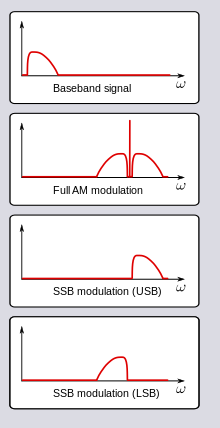
A | B | C | D | E | F | G | H | CH | I | J | K | L | M | N | O | P | Q | R | S | T | U | V | W | X | Y | Z | 0 | 1 | 2 | 3 | 4 | 5 | 6 | 7 | 8 | 9
This article needs additional citations for verification. (July 2015) |

| Passband modulation |
|---|
 |
| Analog modulation |
| Digital modulation |
| Hierarchical modulation |
| Spread spectrum |
| See also |
In radio communications, single-sideband modulation (SSB) or single-sideband suppressed-carrier modulation (SSB-SC) is a type of modulation used to transmit information, such as an audio signal, by radio waves. A refinement of amplitude modulation, it uses transmitter power and bandwidth more efficiently. Amplitude modulation produces an output signal the bandwidth of which is twice the maximum frequency of the original baseband signal. Single-sideband modulation avoids this bandwidth increase, and the power wasted on a carrier, at the cost of increased device complexity and more difficult tuning at the receiver.
Basic concept
Radio transmitters work by mixing a radio frequency (RF) signal of a specific frequency, the carrier wave, with the audio signal to be broadcast. In AM transmitters this mixing usually takes place in the final RF amplifier (high level modulation). It is less common and much less efficient to do the mixing at low power and then amplify it in a linear amplifier. Either method produces a set of frequencies with a strong signal at the carrier frequency and with weaker signals at frequencies extending above and below the carrier frequency by the maximum frequency of the input signal. Thus the resulting signal has a spectrum whose bandwidth is twice the maximum frequency of the original input audio signal.
SSB takes advantage of the fact that the entire original signal is encoded in each of these "sidebands". It is not necessary to transmit both sidebands plus the carrier, as a suitable receiver can extract the entire original signal from either the upper or lower sideband. There are several methods for eliminating the carrier and one sideband from the transmitted signal. Producing this single sideband signal can be done at high level in the final amplifier stage as with AM [1] [2] but it is usually produced at a low power level and linearly amplified. The lower efficiency of linear amplification partially offsets the power advantage gained by eliminating the carrier and one sideband. Nevertheless, SSB transmissions use the available amplifier energy considerably more efficiently, providing longer-range transmission for the same power output. In addition, the occupied spectrum is less than half that of a full carrier AM signal.
SSB reception requires frequency stability and selectivity well beyond that of inexpensive AM receivers which is why broadcasters have seldom used it. In point-to-point communications where expensive receivers are in common use already they can successfully be adjusted to receive whichever sideband is being transmitted.
History
The first U.S. patent application for SSB modulation was filed on December 1, 1915, by John Renshaw Carson.[3] The U.S. Navy experimented with SSB over its radio circuits before World War I.[4][5] SSB first entered commercial service on January 7, 1927, on the longwave transatlantic public radiotelephone circuit between New York and London. The high power SSB transmitters were located at Rocky Point, New York, and Rugby, England. The receivers were in very quiet locations in Houlton, Maine, and Cupar, Scotland.[6]
SSB was also used over long-distance telephone lines, as part of a technique known as frequency-division multiplexing (FDM). FDM was pioneered by telephone companies in the 1930s. With this technology, many simultaneous voice channels could be transmitted on a single physical circuit, for example in L-carrier. With SSB, channels could be spaced (usually) only 4,000 Hz apart, while offering a speech bandwidth of nominally 300 Hz to 3,400 Hz.
Amateur radio operators began serious experimentation with SSB after World War II. The Strategic Air Command established SSB as the radio standard for its aircraft in 1957.[7] It has become a de facto standard for long-distance voice radio transmissions since then.
Mathematical formulation

Single-sideband has the mathematical form of quadrature amplitude modulation (QAM) in the special case where one of the baseband waveforms is derived from the other, instead of being independent messages:
| (Eq.1) |
where is the message (real-valued), is its Hilbert transform, and is the radio carrier frequency.[8]
To understand this formula, we may express as the real part of a complex-valued function, with no loss of information:
where represents the imaginary unit. is the analytic representation of which means that it comprises only the positive-frequency components of :
where and are the respective Fourier transforms of and Therefore, the frequency-translated function contains only one side of Since it also has only positive-frequency components, its inverse Fourier transform is the analytic representation of
Antropológia
Aplikované vedy
Bibliometria
Dejiny vedy
Encyklopédie
Filozofia vedy
Forenzné vedy
Humanitné vedy
Knižničná veda
Kryogenika
Kryptológia
Kulturológia
Literárna veda
Medzidisciplinárne oblasti
Metódy kvantitatívnej analýzy
Metavedy
Metodika
Text je dostupný za podmienok Creative
Commons Attribution/Share-Alike License 3.0 Unported; prípadne za ďalších
podmienok.
Podrobnejšie informácie nájdete na stránke Podmienky
použitia.
www.astronomia.sk | www.biologia.sk | www.botanika.sk | www.dejiny.sk | www.economy.sk | www.elektrotechnika.sk | www.estetika.sk | www.farmakologia.sk | www.filozofia.sk | Fyzika | www.futurologia.sk | www.genetika.sk | www.chemia.sk | www.lingvistika.sk | www.politologia.sk | www.psychologia.sk | www.sexuologia.sk | www.sociologia.sk | www.veda.sk I www.zoologia.sk
















